Speech The Evolving Financial Situation

Malcolm Edey
Assistant Governor (Financial System)
Finsia Financial Services Conference 2009
Sydney –
- Audio 14.5MB
- PDF version 226KB
Good morning, and thank you to Finsia for the invitation to speak here today.
We're fortunate to be meeting today in an environment where the worst of the financial crisis seems to be behind us.
This time last year, things were very different. World financial markets were reacting to the extraordinary events of the month before – the failure of Lehman Brothers, and the string of other high-profile failures and near-failures that occurred in the United States and Europe around the same time. Confidence was collapsing, equity prices were falling sharply and wholesale credit markets were in a state of serious dysfunction. These events, in turn, were driving a severe downturn in global spending and output.
Today we can see with hindsight that the period of maximum disruption to the world financial system extended over roughly the six months from September 2008 through to March this year. It was during this period, too, that governments around the world were responding with some of their most significant measures of emergency support, including expanded depositor protection, guarantees for banks' wholesale debt, and in some cases direct injections of capital into the banking system. All of that was in addition to the substantial stimulus from monetary and fiscal policies aimed at alleviating the general economic downturn. Taking these things together, there's no doubt that the scale of both the crisis itself, and the set of policy responses to it, have been the largest in more than a generation.
That was the situation a year ago. The good news is that things are now improving, and have been for some months. The world economy is returning to growth, confidence has picked up and, over the last six months or so, financial market conditions have improved significantly on a number of fronts.
Given these developments, my theme today is one of cautious optimism about the global situation. We can't yet say that things are back to normal, and we still can't rule out further setbacks. But the extreme downside risks that dominated the scene a year ago now seem to have faded. And throughout this period, the Australian banking system has proven to be a lot more robust than some of its counterparts abroad.
I'll take the opportunity to elaborate on those themes by drawing on material from our recent Financial Stability Review, which was released last month. Along the way, I'll also try to highlight some areas of continuing risk that still need to be watched.
The Global Financial Environment
A good place to start is with global equity and credit markets.
Given the central position of the banking sector in the unfolding of the crisis, it's not surprising that when equity prices were falling, bank shares generally fell more sharply than the market as a whole. Taking July 2007 as a starting point, bank shares in the United States, the euro area and the UK all lost around 80 per cent of their value by the time the trough was reached, with the steepest falls being concentrated in the six–month period after the Lehman collapse. But since March this year there has been a significant turnaround. Bank shares have generally been outperforming the wider market on the way up, and in those same economies they have now recovered around a third of their earlier lost ground.
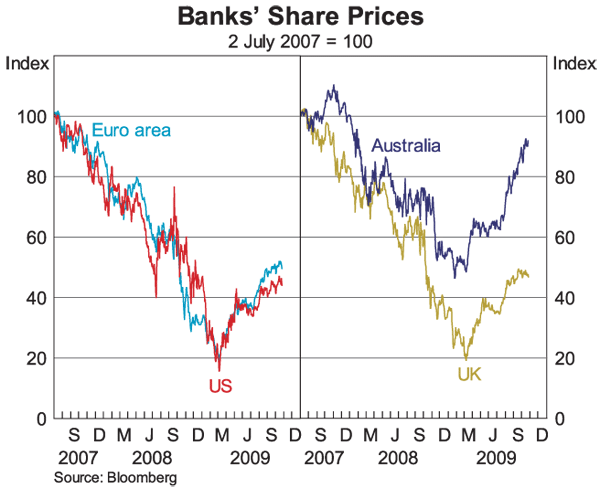
It's interesting to note in passing here the comparative performance of the major Australian banks. On a number of counts the Australian banks have been much more resilient through the crisis period than their counterparts overseas, and this was reflected, among other things, in a less severe fall in their share prices. I'll say more about the Australian banks later.
Another indicator of the general improvement in confidence has been a narrowing of financial risk premiums. After widening spectacularly late last year, bank CDS premiums, for example, have generally now returned to pre-Lehman levels, although they're still high by earlier standards. There has also been a substantial narrowing of spreads on bank bonds over government securities, and in short-term spreads between banks' wholesale borrowing costs and expected official rates. All of those markets have been moving in the same direction, towards greater normalisation.
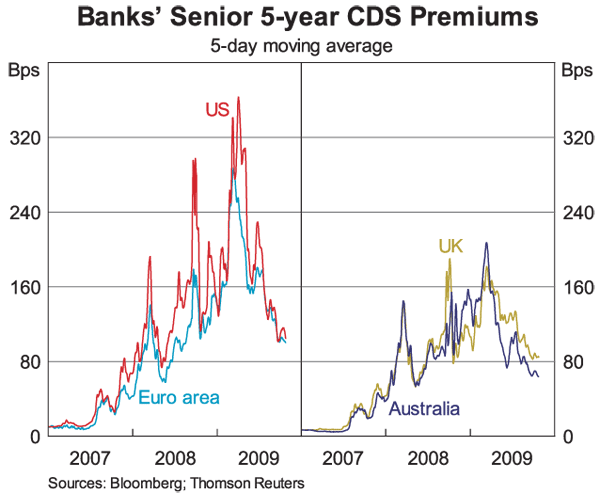
So the extreme risk aversion of late last year has been easing for some months now, and banks' access to wholesale funding markets has been improving. It's important to keep this in perspective: these market indicators are still, in some cases, a long way from pre-crisis levels, particularly for borrowing costs at longer maturities. But the improvement over recent months is nonetheless encouraging, and it has been broadly based across a range of major economies and markets.
There are several factors we can point to that have underpinned this recent recovery in sentiment. They include improved prospects for the global economy, the government policy actions that I talked about earlier, and the actions of banks themselves to begin the task of repairing their balance sheets. In the United States, the stress tests that were done earlier this year prompted significant capital raisings by some of the major banks; and by making the potential capital needs clearer, the exercise seems to have contributed to the broader rebuilding of confidence.
Another important contributor to confidence has been a recovery in bank profitability. Losses of the major global banks generally peaked in the second half of 2008. In the United States, federally insured banks collectively lost around US$12 billion last year, but in 2009 to date they have recovered to a position of aggregate profit. Broadly similar profit recoveries have been seen at the aggregate level in the UK and the euro area. Within those aggregates, of course, there is significant variation at the level of individual banks.
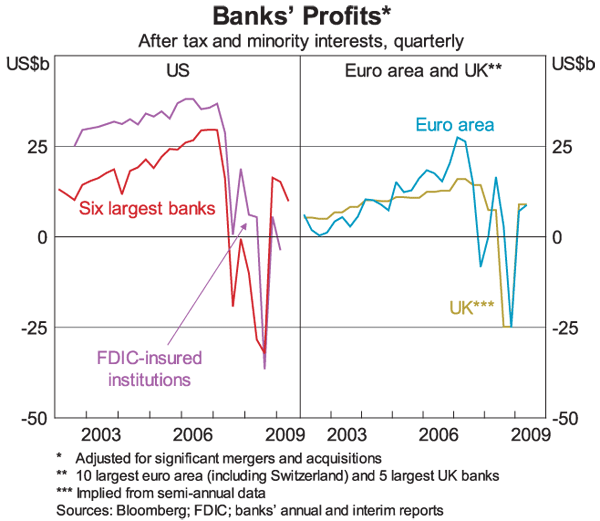
While all of this is encouraging from a financial stability viewpoint, there are still challenges ahead. One reason for the sharp spike in losses, and the subsequent rebound in profitability, is the one-off nature of the securities (and other asset) write-downs that were concentrated in the second half of last year. Crisis-related securities losses by the largest international banks are estimated to have peaked at over US$200 billion in the second half of 2008, and then fallen to around US$60 billion in the first half of this year. This factor on its own made a big contribution to the turnaround in total profits, but it is essentially a short-term influence.
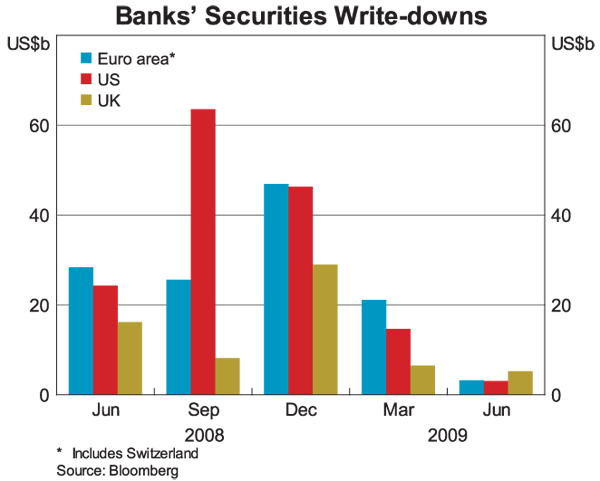
The factor that will take longer to play out will be the evolution of losses from banks' on-balance-sheet lending. Over the past two years, loan loss provisions by banks in the US and Europe have increased substantially, although they were coming from a low level. Based on data for a group of the largest banks in these economies, loan losses were up by 70 per cent in the first half of 2009 from their levels a year earlier. In the case of the major US banks, they were running at around 4½ per cent of the aggregate loan book.
It's difficult to say at this stage how quickly these loan losses might start to taper off. In the United States, loan performance up to this point has been deteriorating across all the main categories of lending. Charge-off rates have been particularly high for consumer debt, where loan quality has been affected by a combination of poor lending practices and rising unemployment. It's possible that losses in this area will rise further. But perhaps the more important area to watch, both in the US and elsewhere, will be exposures to commercial real estate. With commercial property prices having fallen significantly in many countries, loans to this sector are generally expected to be amongst the worst performing. And past experience suggests that the dynamics in this sector may take a while yet to unfold.
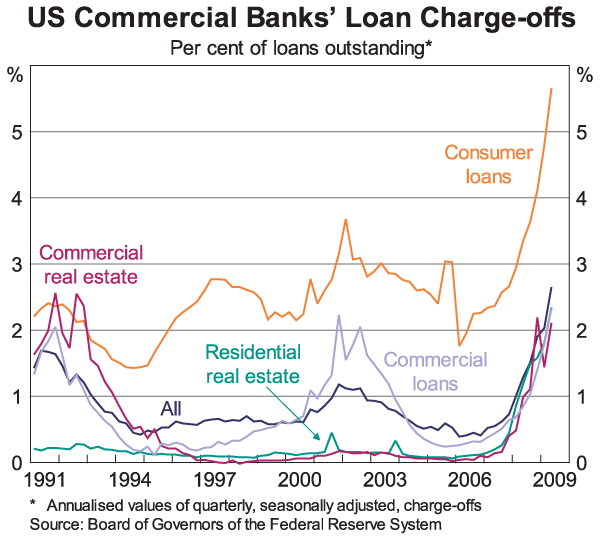
Having raised that point of caution, however, it's important to recognize that real progress has been made in strengthening banks' balance sheets since the crisis broke out. The profit recovery has assisted with this, but banks have also been taking active steps to strengthen their balance sheets by selling non-core assets and raising new capital, as well as benefiting in a number of cases from public capital injections. In total, the largest banks in the US and Europe have raised nearly US$500 billion of new capital since the fourth quarter of last year. While a lot of that came initially from public sources, in a number of cases that has now been replaced by private investment.
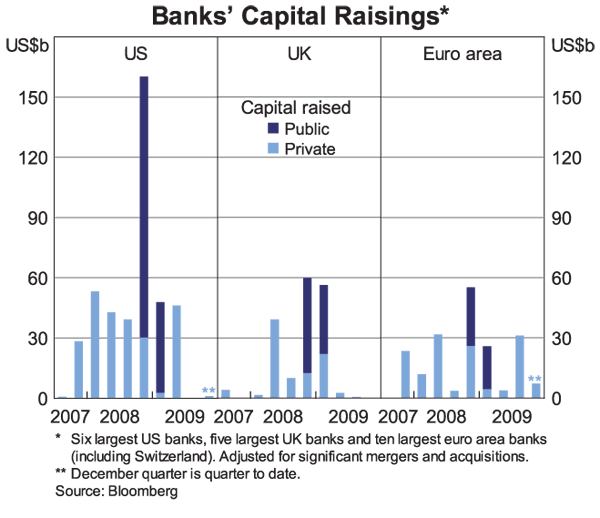
Another encouraging development internationally has been improved access to non-guaranteed wholesale funding. As I said earlier, risk spreads on a range of credit instruments have been narrowing significantly from last year's peaks. At the short end of the curve, spreads on 3-month wholesale funding relative to expected official rates have more than fully reversed their post-Lehman spikes. They are still higher than pre-crisis levels, but those should not be regarded as permanent norms.
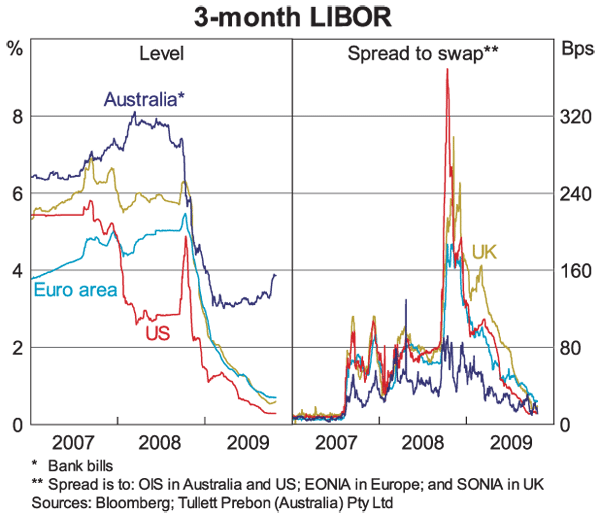
At the long end of the curve, the contraction in spreads has been less pronounced, but is nonetheless helping to make unguaranteed issuance more attractive. In conjunction with some other factors, this has contributed to a decreased reliance on the use of guaranteed debt around the world. Over the past six months, the bulk of issuance by US banks, for example, has been in the unguaranteed market.
Attention in many countries has now turned to how to exit from these emergency support arrangements. The US government has confirmed that its wholesale guarantee scheme will expire at the end of this month. The most common expiry dates in other major economies are at the end of 2009, although some are later.
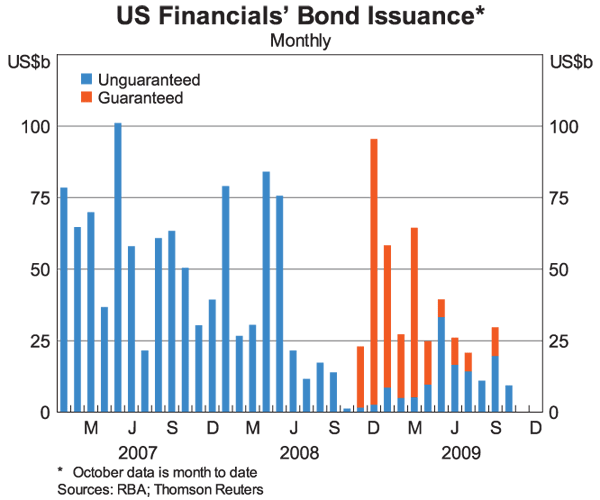
Before I turn to Australia, one final point to make about international financial conditions is that the process of de-leveraging and balance-sheet repair also has its counterpart in the private non-financial sectors. Both the household and business sectors in the major economies have been reducing their levels of debt, and businesses around the world have substantially increased their raisings of equity. For the time being, this is an environment where the private sector's demand for credit in the major economies could remain quite weak.
The Australian Financial System
Let me turn now to the domestic scene.
Overall, the Australian banking system has remained resilient throughout the crisis period.
One very clear point of contrast to the situation elsewhere in the world is that the Australian banking sector has remained profitable. For the major banks, the rate of return on equity has so far fallen only modestly. In the latest half-year, it dipped to around 13½ per cent. This is lower than it had been for a few years prior to that, but still a very strong performance in the circumstances.
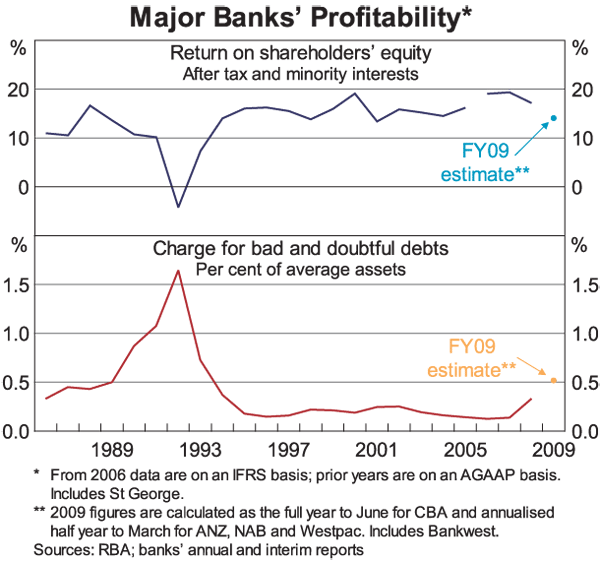
There has, however, been some diversity of performance across the different categories of domestic banks. The smaller banks, including the regionals, have reported a sharper decline in profitability, partly because their loan losses have increased faster. They were also less successful than the major banks in maintaining growth of their net interest earnings. Nonetheless they have, to date, remained in profit overall.
There are a number of factors that have contributed to the overall resilience of the Australian banks, in what has been a very difficult environment internationally.
An important general point is that the performance of the financial system is closely interrelated with the performance of the economy itself. Australia came into the most intense phase of the crisis period in better shape than most, and with more scope than most to make timely macroeconomic policy responses. Partly as a result of that, the overall slowdown in the economy has been much milder than elsewhere. We have also benefited from our close linkage with the Asian region, where financial sectors were less affected by the crisis and economic conditions have bounced back reasonably quickly. In fact, what's commonly referred to as a global financial crisis has been mainly a crisis of the United States and Europe.
That said, there have also been important aspects of the Australian financial system itself that contributed to domestic resilience. One is that the Australian banks had only very limited exposure to the types of securities that led to major losses abroad – US mortgage-backed securities, CDOs and the like. The Australian banks were making good profits in their domestic operations and, in a period when banks in some other jurisdictions were building up large portfolios of high-risk securities, the Australian banks tended to focus their activities on domestic lending.
Another factor is that the quality of banks' on-balance-sheet loans did not deteriorate to anywhere near the same extent as occurred in the United States and Europe. The difference here is particularly striking for the housing loan portfolio. In Australia, despite a gradual increase over the past few years, banks' non-performing housing loans are still only a bit over ½ of one per cent of the amounts outstanding. In the UK and Spain, that ratio is between 2 and 3 per cent, and in the US it is approaching 6 per cent. These differences tell us something about the deterioration in lending standards that occurred elsewhere, but they also testify to the generally sound practices that have continued to prevail in the Australian housing market over recent years. And this in turn has made a very important contribution to the banks' overall balance-sheet quality, given that housing loans comprise around 60 per cent of their aggregate loan book.
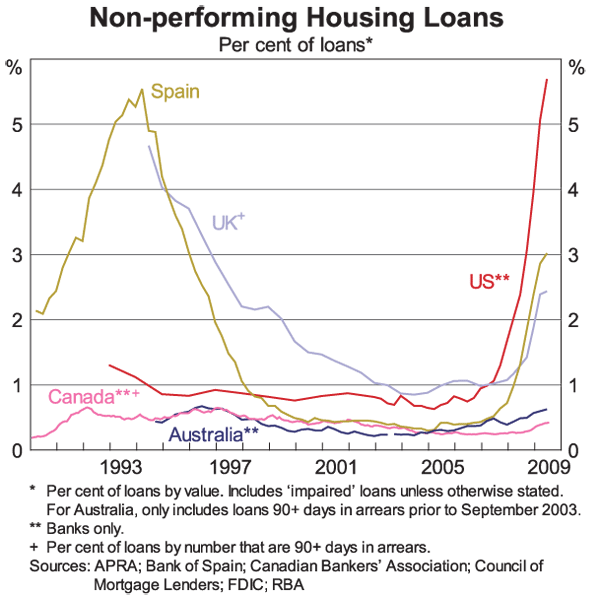
There has, however, been a more significant deterioration in loan quality in the business portfolio. Impairments on commercial property loans have been increasing over the past couple of years, and business loan losses more generally have picked up as the economy slowed. This will remain an area to watch in the period ahead. Nevertheless, banks' aggregate impairment rates are still low in comparison to other countries, and they are only a fraction of the level they reached here in the early 1990s. The banks are well capitalised, and they have strengthened their balance sheets further over the past year with significant additional raisings.
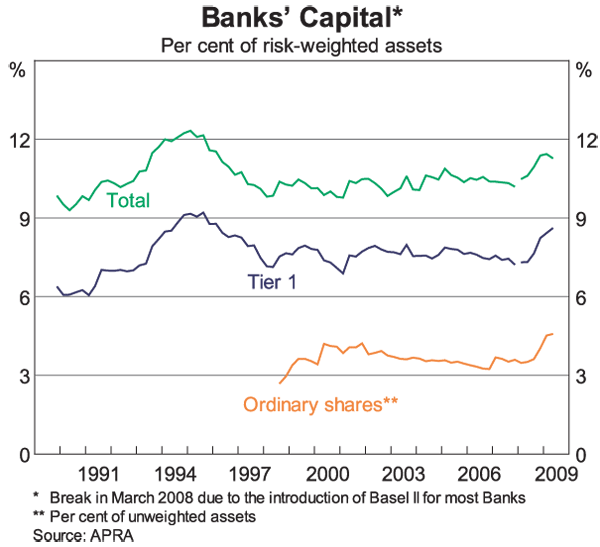
With asset quality generally remaining resilient, the main effect of the global crisis on Australian banks has been through its effect on funding conditions. As was happening elsewhere in the world, wholesale funding became both more expensive relative to the policy rate, and more difficult to obtain. And at the height of the crisis, some markets were effectively closed altogether. The introduction of the guarantee scheme late last year played an important role in ensuring continued access to wholesale funding for the Australian banking system, and in that way enabled the system to continue lending through the most intense phase of the crisis.
But for some months now, the strains in global markets that gave rise to these difficult conditions have been gradually easing. Australian banks have benefited from the general narrowing in risk spreads and the increased tolerance for risk that I discussed earlier. Short-term wholesale spreads for Australian banks have contracted quite markedly and, at longer terms, the availability and cost of unguaranteed funding have improved. As a result, the proportion of banks' long-term issuance that is unguaranteed has been increasing: it rose from next to nothing at the end of last year to around 75 per cent in the latest month.
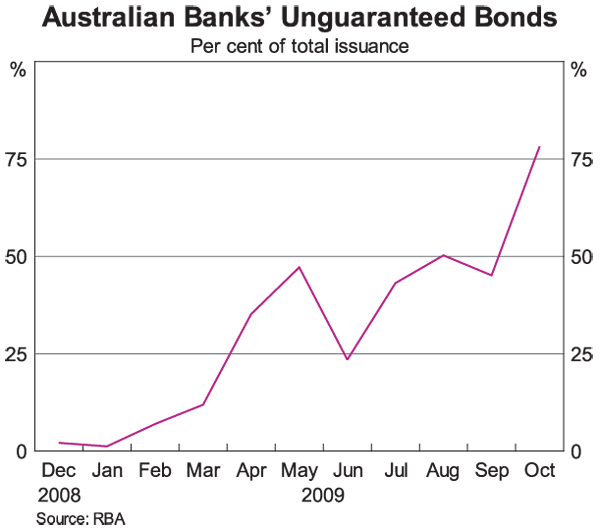
Another consequence of the recovery in risk appetite is that spreads in the Australian mortgage-backed securities market have narrowed. Again, they are still high by earlier standards, but they have narrowed sufficiently to support some renewed issuance to private investors over the last couple of months. All of these are encouraging signs, and certainly a significant improvement on conditions earlier in the year.
Conclusion
As I said at the outset, my theme today has been one of cautious optimism.
The past year has been an extremely challenging time, but Australia's financial system, like the economy itself, has come through it in better shape than most.
Globally, we can't yet say that conditions have returned to normal. Risk pricing in a number of areas is still high, and there are still some areas of significant risk on financial-sector balance sheets. But the extreme dislocation of a year ago has passed. Market conditions have been on an improving trend for several months, and the risks to the world financial system now seem much more evenly balanced than they were.